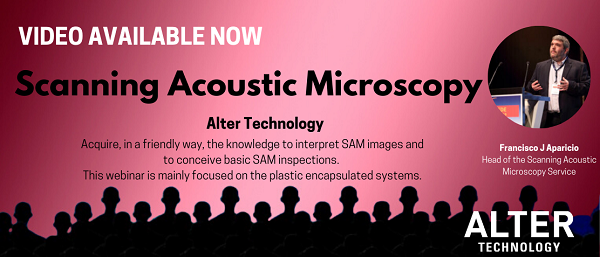C-SAM Questions & Answers
- Posted by Francisco Javier Aparicio Rebollo
- On July 7, 2020
- 0
In this post, you can read all the questions launched by the attendees, as well as all the answers
offered by the speaker.
Q.- Did I get that correctly that the inspection is done in the water? If yes – how long does the inspection take? How do you make sure the part is dry later on and doesn’t start to corrode?
A.- You are right. The inspection must be conducted in a liquid coupling media, typically water. Inspection time ranges from a few minutes to longer depending on the inspected area and required resolution.
To avoid corrosion, we always use deionized water.
In addition, we can dry the sample by moderate heating in an air circulating oven, in agreement with the customer-defined conditions.
Q.- As the measurement is done underwater, would it be possible to use SAM to analyse water penetration in packages? If yes, to what extent? (sensibility, thickness of the interface etc.).
A.- We can detect the incorporation of water through surface-breaking delamination.
Q.- How can you be sure that the water is not creating defects?
A.- To avoid/limit the potential adverse impact of water incorporation during the SAM inspections we take the following measures:
- All the inspections are conducted in low-conductivity deionized water.
- The immersion time is limited to the minimum required to acquire high-quality images and representative A-scans. With this aim, we frequently make use of other non-destructive inspection techniques (e.g. X-ray inspection) to get the first insight into the internal structure and therefore decrease the focalization time.
- After inspection, we can dry the samples in an air circulating oven. Heating conditions are agreed with the customer to preserve the functionality of the specimen.
Thanks to these precautions, we do not observe corrosion sings in the case of the samples that are de-encapsulated and inspected by SEM within DPA test flows.
Q.- NEPP has reported the influence of moisture penetration in the plastic packaged part resulting in false defects in C-SAM. Did you experience the same phenomenon?
A.- Yes, we have experience in this phenomenon. As you comment, fast water ingress may lead to misleading info and not reliable results. To tackle this issue, we systematically register, at the beginning, a quick (low-quality) pre-inspection. This approach allows us to identify such evolution phenomena. In the case of a fast water ingress process, this information is used for the correct image interpretation. If needed, we can provide our customers with these initial images to be aware of these effects.
Q.- Why not use fluor-carbon liquids such as those used for gross-leak detection?
A.- We offer this possibility. But this increases the price and makes the analysis much more complex due to the different acoustic properties.
A.- Yes, but in the case of cavity packages, the inspection is frequently limited to the die attach. Right now, you are watching in the presentation some examples of such inspections on metal packages.
Q.- Do you always perform X-ray before a C-SAM investigation of a new part type?
A.- Yes, in the case of an unknown sample. The goal of the x-ray inspection is to determine the best SAM inspection conditions before immersion in water. In this way, we limit water incorporation effects.
Q.- How different are radiography and Surface acoustic microscopy give that both are used to detect defects within the IC. The obvious difference would be the source, apart from that any other differences?
A.- The most important difference is the much higher sensitivity of the acoustic method for the detection of thin air cavities or gaps that cannot be detected by X-ray inspection. In this regard, note that the thickness of typical delamination if very frequently below 1 um. This is the reason why package-delamination, normally, cannot be detected by X-ray inspection. On the contrary, SAM techniques permit the reliable detection of such thin cavities or even thinner, below 100 nm. Moreover, SAM can be used for the inspection through hard metals such a lead (non-possible by X-ray).
Q.- Can it be used if we have a metal package?
A.- Yes, but in the case of cavity packages, there are some limitations. In the webinar, you have some examples of the inspection of metal packages and metal assemblies.
Contact us
- Material Analysis Techniques for Electronic Components - May 6, 2022
- SAM: Survey to manufacturers and users - February 17, 2022
- What is a C-SAM Inspection? - January 29, 2022



0 comments on C-SAM Questions & Answers